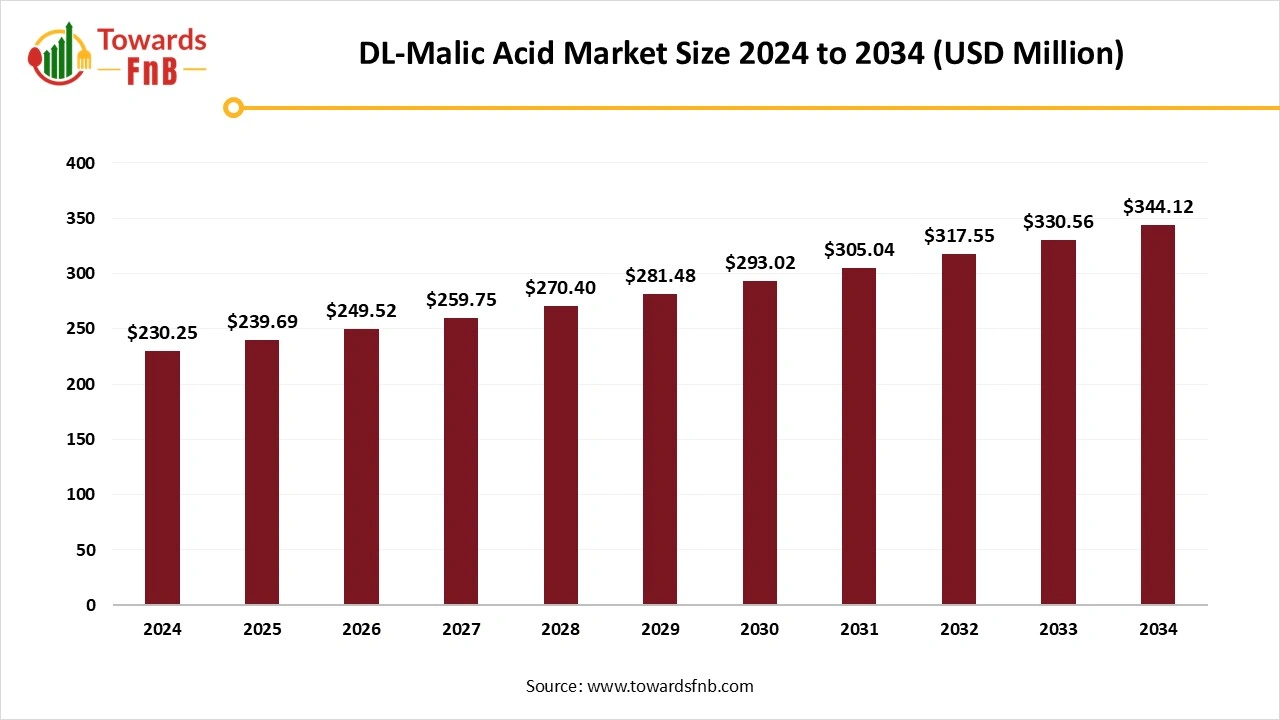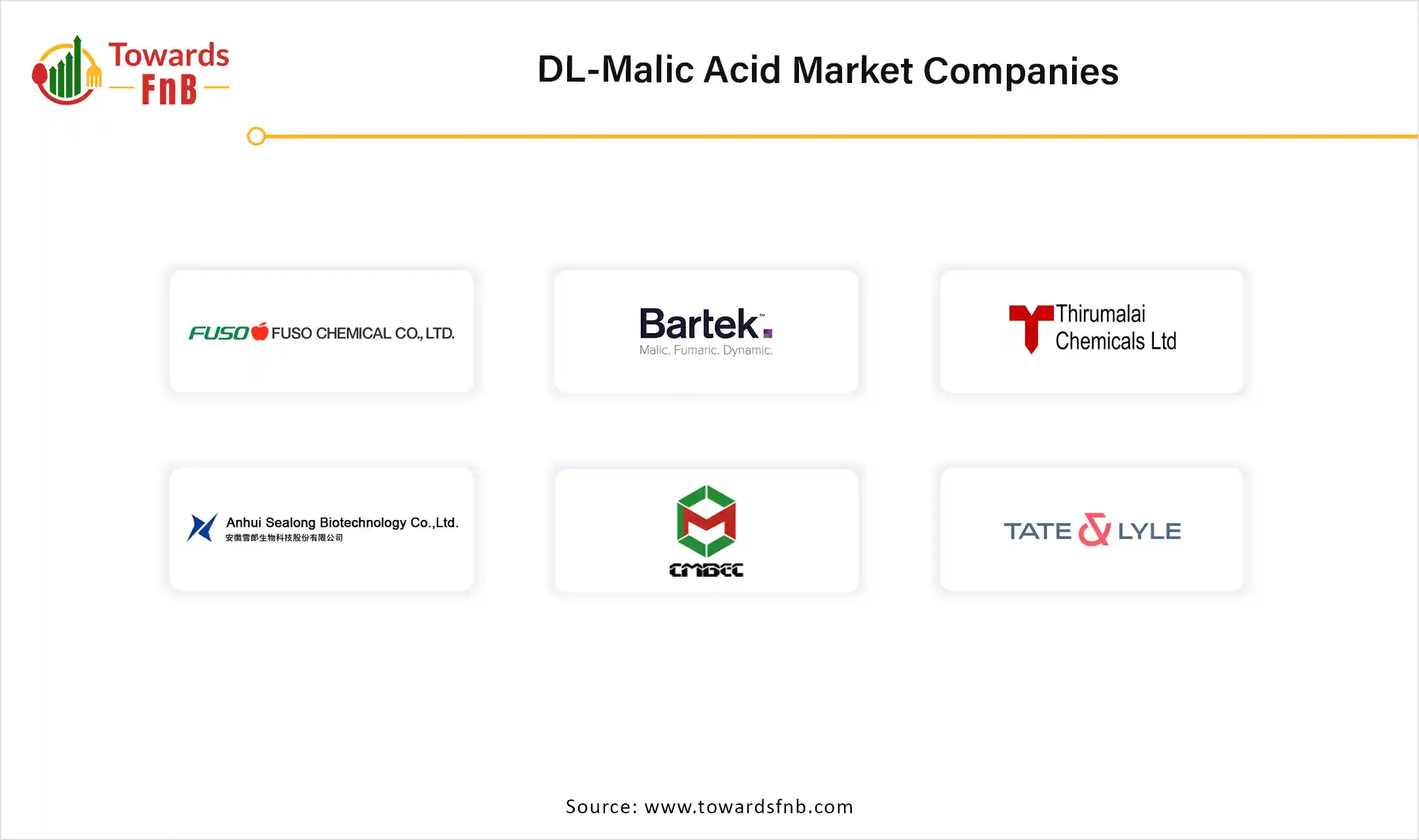November 2025
The global dl malic acid market size was estimated at USD 230.25 million in 2024 and is expected to rise from USD 239.69 million in 2025 to nearly reaching USD 344.12 million by 2034, growing at a CAGR of 4.1% during the forecast period from 2025 to 2034. The market is significantly growing due to its wide applications to several industries, increasing consumers' demand for eco-friendly and clean label ingredients along with technological advancements in the DL-Malic acid production process.

| Study Coverage | Details |
| Growth Rate from 2025 to 2034 | CAGR of 4.1% |
| Market Size in 2025 | USD 239.69 Million |
| Market Size in 2026 | USD 249.52 Million |
| Market Size by 2034 | USD 344.12 Million |
| Largest Market | Asia Pacific |
| Base Year | 2024 |
| Forecast Period | 2025 to 2034 |
| Regions Covered | North America, Europe, Asia-Pacific, Latin America, and Middle East & Africa |
DL-malic acid is a synthetic mixture of D - and L-isomers of malic acid, typically produced via chemical synthesis from maleic anhydride. It is widely used as an acidulant, flavor enhancer, and pH regulator in food & beverages, personal care, pharmaceuticals, and industrial applications. Compared to L-malic acid (naturally occurring), DL-malic acid is cost-effective and has broader industrial use due to ease of production and storage.
DL-malic acid market is expanding due to its various applications and the growing demand for organic, naturally derived and clean-label across diverse industries. DL-malic acid can be used as an excipient in several formulations of drugs. It also finds extensive applications in cosmetic and skincare industries as it offers exfoliating properties which is essential for skin rejuvenation and firmness to appear as a healthy skin. Similarly, DL-malic acid can be utilized to impart tart taste in different products of food and beverage industry which comprises candies, jellies and various other beverages, expanding its market reach on a global scale.
A significant opportunity that the DL-malic acid market is experiencing is the emergence of new formulations of DL-Malic acid due to technological integration and massive investment in research and development to use it as a novel ingredient in a diverse sector. The competitive landscape is further reshaped by major key players' strategies and marketing campaigns which represent the potential value of DL-malic acid.
Moreover, increasing environmental issues are prompting manufacturers to adopt eco-friendly manufacturing practices along with sustainability. By understanding a series of toxic elements and their increasing adverse effect on human health, the environment and food chain, consumers are also shifting their preferences, which has led manufacturers to follow string rules of regulatory frameworks and food safety standards and strictly comply with them to gain consumers' trust in their brand.
A prominent challenge that DL-malic acid faces is fluctuations in the raw material price as it is derived from maleic anhydride and fumaric acid. This fluctuation is impacting production cost and profitability, eventually leading to the volatility in the price of DL-malic acid for consumers. Price swings causes include geopolitical tensions, supply chain disruptions, changing demand from the petrochemical industry, and other local issues. By looking at these factors, manufacturers become susceptible to the profit margin of DL-malic acid and are unable to maintain production costs and a competitive edge from other synthetic compounds which mimic DL-malic acid, further hampering the growth of the DL-malic acid market globally.
How is the Growing Consumer Base in Asia Pacific Thriving DL-Malic Acid Market?
Asia Pacific leads the DL-malic acid market while holding a share of 45-50% in 2024 and the region is expected to grow at the fastest CAGR during the foreseeable period. The region is experiencing a robust growth rate due to factors like an increasing and huge consumer base in the region, an expanding food and beverage industry, a stronghold on manufacturing processes, and cost-effectiveness due to increased research and development along with a thriving personal care and pharma industry. Granular DL-malic acid is comparatively cheaper than other forms and is the most demanding form of malic acid for large-scale industries.
Asia Pacific has highly developed production plants with dedicated supply chain facilities for DL-malic acid that are cost-effective and offer easy access to the abundant raw materials required to produce high-quality DL-malic acid, the underlying cause of the region’s dominance over the market. Additionally, an increasing consumer base along with an already huge consumer base due to a high population rate in countries like India and China is fueling market demand as people are opting for personal care products, including DL-malic acid, as an ingredient owing to the awareness of its benefits.
Which are the Factors Affecting the North America DL-Malic Acid Market?
North America is expected to showcase a notable growth rate during the foreseeable period. The region is observing a notable growth rate due to various factors such as the expansion of functional and confectionery products, the proliferating food and beverage sector in the region, and growing health-conscious consumers in the region. On a country level, the U.S. market is anticipated to witness the largest market revenue due to a stronghold of the food and beverage industry and customer choices, which include health and safer products with clean ingredients like DL-malic acid. Moreover, the highly developed pharmaceutical industry is also supporting the market’s growth in North America as DL-malic acid is used in various formulations of medicines to treat different health issues, chronic and seasonal infections.
Why is the Application of DL-Malic Acid Most Seen in Beverages?
The beverages segment dominated the global DL-malic acid market in 2024. The segment is dominating due to various factors, like DL-malic acid can be used to enhance the flavor of food products as per the desired taste/ flavor. It can work as a barrier to moisture, which is similar to that of preservatives used in foods, for longer shelf life and maintain the product’s quality to reduce waste. Carbonated drinks and fruit juice mainly require DL-malic acid to provide tartness, which increases the flavor profile.
The cosmetics & skincare segment is expected to witness the fastest CAGR during the foreseeable period. The segment is expanding due to it showing multifunctional properties like an exfoliant and cleaning agent which offers rejuvenation for the skin. It is considered a natural and sustainable ingredient for skincare products. Also, a growing trend for skincare regimens is fueling the market’s demand further.
Why is the Powder Form DL-Malic Acid Most used for industrial Purposes?
The powder segment dominated the global DL-malic acid market in 2024. The segment is dominating due to factors like its easy use and handling, help in stability and longer shelf life of products, growing use of the food and beverage sector, and demand for clean and safe ingredients in accounting for environmental concerns. The powder form is generally stable in every climate condition and does not interact violently with any other substance, which makes it safer than any other form. Thus, it is majorly incorporated into food and beverages as a clean and safe ingredient.
The Liquid Segment is Expected to Grow at the Fastest CAGR During the Foreseeable Period.
The liquid form of DL-malic acid is easily soluble and comfortable to use without any complex processes. It leads to better and expected consistency, and the mixing of products is a major driving factor for the segment’s growth globally. The beverage industry is also transforming by adding clean label ingredients manufactured with eco-friendly processes and is further supporting the market’s growth.
Why does the Food Sector Require the Highest Purity Level of DL-Malic Acid?
The food grade segment dominated the global DL-malic acid market in 2024. The segment is dominating due to increasing consumption of natural and clean-labeled products to stay energetic and healthy, versatile application of DL-malic acid along with widening food and beverage sector across the globe. Regulations for food and beverages are also stringent and need to be followed strictly by manufacturers to avoid penalties and gaining consumers' trust is a major driver of the segment's growth, which has led to market expansion on a global scale.
The Pharmaceutical Grade Segment is Expected to Grow at the Fastest CAGR During the Foreseeable Period.
The segment is proliferating owing to its increasing demand in several applications, like pharmaceuticals, cosmetics, and nutraceuticals/dietary supplements. People seek high-quality and clean products by considering the side effects of cheap and unauthorized products' use is further increasing the segment’s trajectory in the global DL-malic acid market.
Why is DL-Malic Acid Widely Accepted by the Food & Beverages Industry?
The food and beverage segment dominated the global DL-malic acid market in 2024. The segment is dominating due to DL-malic acid acting as a flavoring agent, preservative, and offering a tart taste profile. Also, it is comparatively cheaper in price than other alternatives, which is a key driver of why the food and beverage industry has adopted it as a leading ingredient. Its versatility offers a wide range of applications in food products and carbonated, or non-carbonated beverages, further expanding the market’s reach globally.
The cosmetics & personal care segment is expected to grow at the fastest CAGR during the foreseeable period. The segment is significantly expanding as DL-malic acid has various properties, such as exfoliant, pH balancer, skin moisturizer with safer molecules that do not violently react with any other substances and additionally sustains moisturization/hydration by working as a skin barrier for climatic wear and tear.
Why is the Direct Sales Channel the Most Expanded in the Global DL-Malic Acid Market?
The direct sales (B2B) segment dominated the global DL-malic acid market in 2024. The segment is dominating due to various DL-malic acid businesses preferring to deal with highly established suppliers and distributors to break the supply chain cycle and continue their businesses. Direct sales channel, providing reliable and regulatory-proof DL-malic acid products. Also, direct sales channel distributors understanding what exactly the customer is looking for is a major key driver for the segment's growth.
The Online Retail Segment is Expected to Grow at the Fastest CAGR During the Foreseeable Period.
The segment is expanding due to a growing shift towards natural, clean ingredients in various sectors like food and beverages, the cosmetics industry, and others. Also, online shopping offers high comfort and the convenience of doorstep delivery of desired products without any hustle to go outside and purchase or find products with uncertainty is a key driver of the segment's growth.
BIOKING
Bartek Ingredients Inc.
NNB Nutrition

By Application
By Form
By Purity Level
By End Use Industry
By Sales Channel
By Region
The global fermented ingredients market size is projected to grow from USD 43.53 billion in 2025 to USD 113.18 billion by 2034, reflecting a CAGR of 1...
The global dietary fibers market size is projected to grow from USD 9.56 billion in 2025 to USD 21.81 billion by 2034, growing at a CAGR of 9.6% durin...
The global nutraceutical ingredients market size is forecasted to reach from USD 95.77 billion in 2025 to USD 191.45 billion by 2034, expanding at a C...
The global quick service restaurants market size is expected to grow from USD 1,059.00 billion in 2025 to USD 2,303.83 billion by 2034, at a CAGR of 9...
November 2025
November 2025
November 2025
November 2025